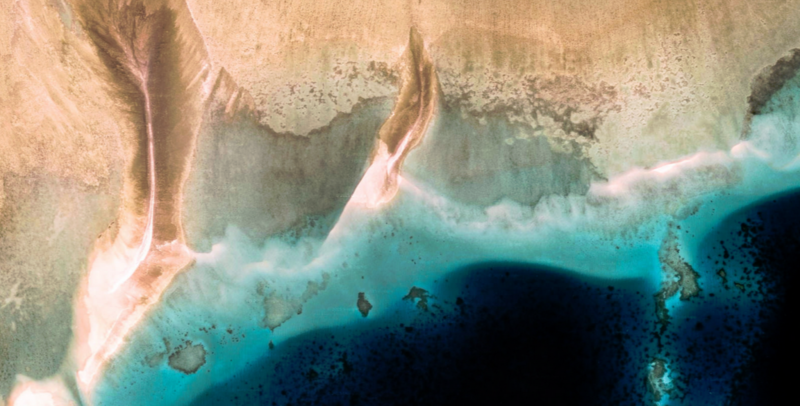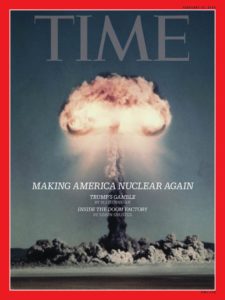File:Marshall nuclear memories.png

Original file (1,152 × 584 pixels, file size: 1.05 MB, MIME type: image/png)
Bikini Atoll nuclear test: 60 years later and islands still unliveable
Marshall Islands, scene of huge US hydrogen bomb test in 1954
The Marshall Islands are marking 60 years since the devastating US hydrogen bomb test at Bikini Atoll, with exiled islanders saying they are too fearful to ever go back because of nuclear contamination.
Part of the intense cold war nuclear arms race, the 15-megatonne Bravo test on 1 March 1954 was a thousand times more powerful than the atomic bomb dropped on Hiroshima. It exposed thousands in the surrounding area to radioactive fallout.
Bikini islanders and their descendants have lived in exile since they were moved for the first weapons tests in 1946. When US government scientists declared Bikini safe for resettlement some residents were allowed to return in the early 1970s. But they were removed again in 1978 after ingesting high levels of radiation from eating foods grown on the former nuclear test site.
The Marshall Islands Nuclear Claims Tribunal awarded more than $2bn in personal injury and land damage claims arising form the nuclear tests but stopped paying after a compensation fund was exhausted.
As those who remembered the day gathered in the Marshall Islands’ capital of Majuro, along with younger generations, to commemorate the anniversary, many exiles refused to go back to the zones that were contaminated despite US safety assurances.
'Think about life, before it's too late and death revisits ...
J. Robert Oppenheimer: "I am become Death, the destroyer of worlds." (Trinity Test, July 1945, the beginning of the Nuclear Weapons era)
We knew the world would not be the same. A few people laughed, a few people cried. Most people were silent. I remembered the line from the Hindu scripture, the Bhagavad-Gita. Vishnu is trying to persuade the Prince that he should do his duty, and, to impress him, takes on his multi-armed form and says, 'Now I am become Death, the destroyer of worlds.'
Video of Oppenheimer -- https://www.youtube.com/watch?v=lb13ynu3Iac
No two transnational issues are more closely related than the abolition of nuclear weapons and global climate instability
- Nuclear war is the biggest potential accelerant of life-threatening climate change
- The resources desperately needed to address climate issues continue to be poured into nuclear weapons and their delivery systems
- The solution to both challenges depends on the same new way of thinking based in the reality that national and international self-interests have merged.
_ _ _ _ _ _ _ _ _ _ _ _ _
In 2007, the late Jonathan Schell spoke presciently about the relationship between nuclear weapons and climate change:
“When I wrote The Fate of the Earth in 1982, I said that, first and foremost, nuclear weapons were an ecological danger. It wasn’t that our species could be directly wiped out by nuclear war down to the last person. That would only happen through the destruction to the underpinnings of life, through nuclear winter, radiation, ozone loss.
There has been an oddity of timing because when the nuclear weapon was invented, people didn’t even use the word ‘environment’ or ‘ecosphere.’ The environmental movement was born later. So in a certain sense the most urgent ecological threat of them all was born before the context in which you could understand it. The present larger ecological crisis in that context.
In other words, global warming and nuclear war are two different ways that humanity threatens to undo the natural underpinnings of human, and of all other, life... we may be in a better position today because of global warming, to grasp the real import of nuclear danger.”
- A Horror Beyond Comprehension - https://www.nytimes.com/books/98/12/06/specials/schell-fate.html
The Fate of the Earth By Jonathan Schell
New York: Alfred A. Knopf
THIS is a work of enormous force. There are moments when it seems to hurtle, almost out of control, across an extraordinary range of fact and thought. But in the end, it accomplishes what no other work has managed to do in the 37 years of the nuclear age. It compels us - and compel is the right word - to confront head on the nuclear peril in which we all find ourselves.
The volume consists (though not quite word for word) of three long articles, which appeared serially in The New Yorker a few months ago. They are the reflections of a person of commanding gifts who has been thinking hard about nuclear realities for many years. The articles have an obvious integrity when gathered together into a single volume, but they are so different in temper and in reach that they should probably be read as separate essays - with pauses for thought in between - rather than as continuing chapters in a book.
Schell's language sometimes stretches well beyond the immediate requirements of the argument. He shares a problem with everyone who undertakes to write about the nuclear peril. How do you use ordinary vocabularies to describe something so immense and so absurd as the deaths of, say, 100 million persons?
How do you talk sensibly about a horror beyond comprehension? Readers, being human, do not generally like to contemplate such things. Writers who use words to try to punch their way through those protective layers of lethargy often find themselves speaking louder and louder, in the hope that the tone of their voices will convey an urgency that the words alone do not. The metaphors multiply, the adjectives become warmer, the tension rises.
The Fate of the Earth, then, is not only a statement. It is a summons, an alarm, a commotion.
_ _ _ _ _ _ _ _
From Jonathan Schell's NY Times Obituary
“For decades, they’ve said I was too idealistic, too unreal,” Mr. Schell said in a lecture at Northeastern University... “But since the Wall Street Journal crowd has spoken up, I’m less in the wilderness.”
- Wall Street Journal / http://www.wsj.com/articles/SB116787515251566636
... unless urgent new actions are taken, the U.S. soon will be compelled to enter a new nuclear era that will be more precarious, psychologically disorienting, and economically even more costly than was Cold War deterrence.
_ _ _ _ _ _ _ _
Renewed Nuclear Arms Race
Returning from the Vault
Nuclear Weapons, Nuclear Tests, Nuclear Use?
_
File history
Click on a date/time to view the file as it appeared at that time.
| Date/Time | Thumbnail | Dimensions | User | Comment | |
|---|---|---|---|---|---|
| current | 17:34, 3 August 2015 |  | 1,152 × 584 (1.05 MB) | Siterunner (talk | contribs) | http://www.greenpolicy360.net/w/Nuclear_nonproliferation Category:Environmental Security Category:Environmental Security, National Security Category:Green Politics Category:Nuclear Free Category:National Security [[Category:Nucl... |
You cannot overwrite this file.
File usage
There are no pages that use this file.
